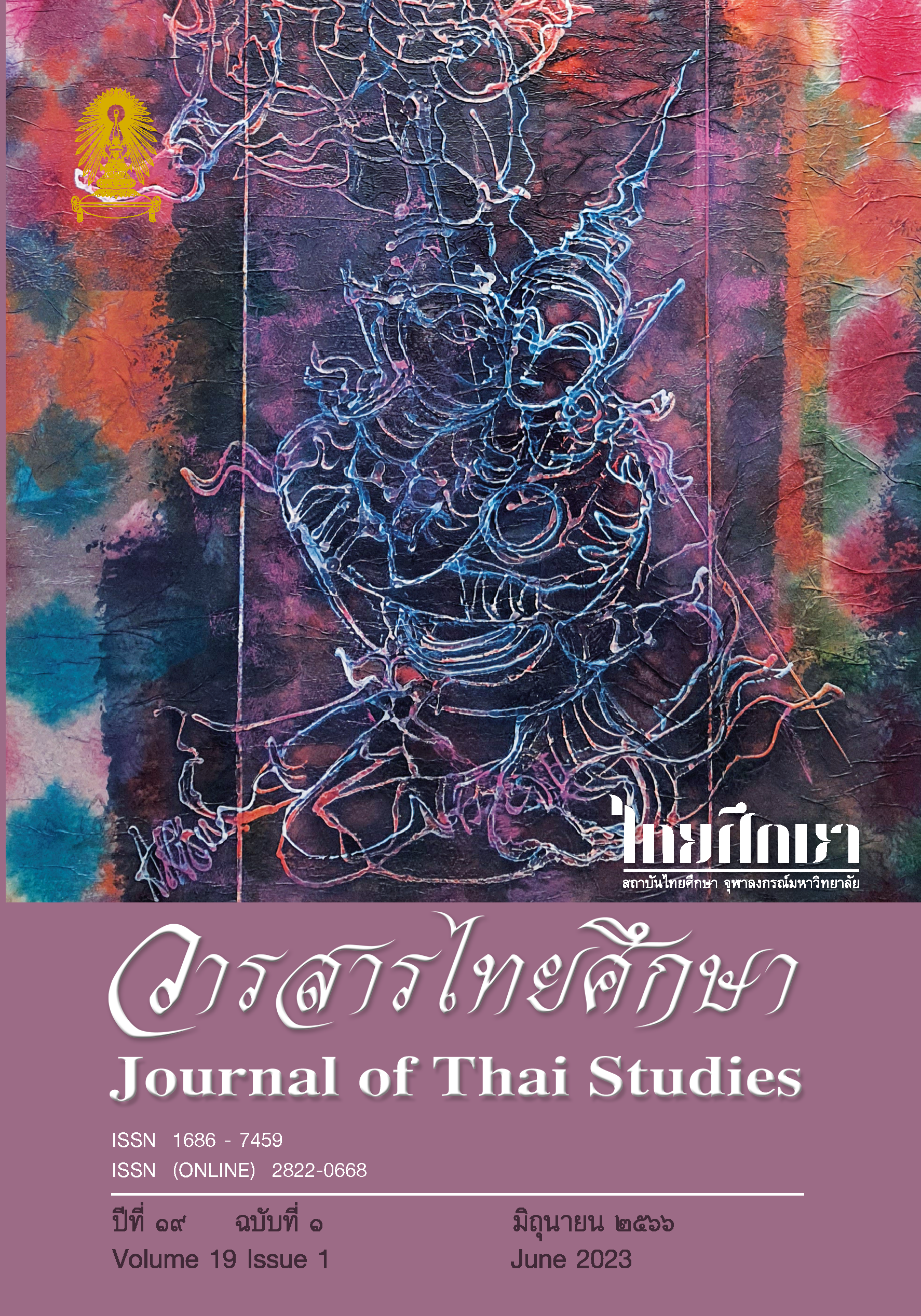Mekhala: The Construction of Semiotic Analysis in Mekhala-Ramasun Performances
Main Article Content
Abstract
The study for this paper analyzed semiotic information and the character of semiotic construction of Mekhala in Mekhala-Ramasun performances. The results revealed that Mekhala-Ramasun performances have taken elements regarding the semiotics of Mani Mekhala from different aspects of representations of the Mekhala-Ramasun story as follows: 1) information from Jatakas in Buddhism; 2) the role of Mekhala and beliefs reflected in rituals that appear in folklore; 3) the creation of Mekhala mythology in terms of the skin color, outfits and the crystal ball, with lightning regarded as her personal identity weapon; and 4) Mekhala, as depicted in painting and sculpture. Elements from these four sources can be found in various performance aspects that have been harmoniously developed. Furthermore, other semiotic elements have been introduced through the Choet-Chin song and Yantra dances.
These are important elements that have resulted in performances in three styles: 1) the Khom sam bai dance; 2) the Yantra dance of Khunying Natthakanurak (Thet Suwanpharata or Thes Suvarnabharata); and 3) the Yantra dance of Thanphuying Paew Sanidvongseni. The latter two dances have created different connotations of Mekhala performances that developed into auspicious performance area. Choet-Chin song and Yantra dances have developed Mekhala performances as the prototype for dance gestures for other performances that were created later. In conclusion, semiotic are an important component of the Mekhala-Ramasun story in creating the Mekhala character that appears in Mekhala-Ramasun performances. This also has a direct impact on the character of Mekhala and other types of performance as the semiotics were created with specific intention, delicacy and integrity.
Downloads
Article Details

This work is licensed under a Creative Commons Attribution-NonCommercial-NoDerivatives 4.0 International License.
Journal of Thai studies is licensed under a Creative Commons Attribution-Noncommercial-NoDerivatives4.0 Intenational (CC BY-NC-ND 4.0) licence, unless otherwise stated. Plese read our Policies page for more information on Open Access, copyright and permissions.
References
Boriharnwanaket, S. (2017). Poramatthatham sangkhep Chit Sangkhep lae Phakphanuak [Summary of Paramatthadhamma and Spirit, and Appendix]. Bangkok: O.S. Printing House Co., Ltd.
Chomklao (Rama IV), H.M.K. (1924). Botlakhon chaprabam. In Botlakhon chut bettalet nai rueang Ramakien [Dance-Dramas. in Various Scenes in Ramakien]. Bangkok: Sophonphiphatthanakon Press.
Chulalongkorn (Rama V), H.M.K. (1920). Phraratchaphithi sip song duean [Royal ceremonies of the twelve months]. Bangkok: Thai Press.
Chulalongkorn (Rama V), H.M.K. (1924). Botlakhon chaprabam. In botlakhon chut bettalet nai rueang Ramakien [Dance-Dramas. in Various Scenes in Ramakien]. Bangkok: Sophonphiphatthanakon Press.
Damrong Rajanubhab, HRH. (1921). Tamnan rueang lakhon Inao [The Legend of the Dance-Drama Inao]. Bangkok: Thai Press.
Damrong Rajanubhab, HRH. (1961). San somdet [Letters of a Princess], Volume 10. Bangkok: Khurusapha Press.
Mahachulalongkornrajavidyalaya University. (1991). Phrasuttatantapidok khutthakanikai chadok Chariyapidok phasa Bali [The Sutta Pitaka, the Basket of Discourse, the Collection of minor works, Chariya Pitaka, in the Pali language]. Bangkok: Winyan Press.
Mahachulalongkornrajavidyalaya University. (1992). Phrasuttatantapidok khutthakanikai chadok phasa Bali [The Sutta Pitaka, the Basket of Discourse, the Collection of minor works, Jataka , Pali language]. Bangkok: Winyan Press.
Mahachulalongkornrajavidyalaya University. (2015). Atthakatha phasa Thai Phrasuttatantapidok khutthoknikai chadok phak 5 [Description in Thai language of the Sutta Pitaka, the Basket of Discourse, a collection of minor works, the Jatakas, part 5]. Bangkok: Mahachulalongkornrajavidyalaya University Press.
Malakul, P. (Mom Luang). (1996). Ngan lakhon khong Phrabatsomdet phraramathibodisisinthon Mahawachirawut Phramongkutklao
chaophaendinsayam lae rachathippatai baep tang tang [Introduction to the dramatic activities of His Majesty King Vajiravudh and varieties of democracy]. Bangkok: Thai Watana Panich Press Co Ltd.
Office of the Royal Development Projects Board (ORDPB). (1995). Phraratchadamrat 4th December 1995 [Royal Speeches, 4 December
. Retrieved from http://km.rdpb.go.th/ Knowledge/View/70
Pemora, (1935). Chan Yaowaphot [Children verses]. The Department of Fine Arts. Bangkok: A chao Press.
Phatnophat, T. (2008). Sanyasat kap phapthaenkhwam [Semiotics and Visual Representation]. Academic Journal of Architecture Chulalongkorn University, 1(1), 35-50.
Phutyotfachulalok (Rama I), H.M.K. (2006). Ramakien. (2nd ed.). Bangkok: Sophon Printing.
Piromanukul, R. (2009). The Analysis Study of the Origin of the Traibhumi Painting Manuscript (Doctor of Philosophy). Silpakorn University, Bangkok, Thailand.
Ratchabandittayasathan. (2011), Photchananukrom chabap Ratchabandit tayasathan [Dictionary of the Royal Institute]. Bangkok: Sirivatana Interprint Public Company Limited.
Sarikabhuti, N. (1972). The Relationship Between the Thai Drama and the Indian Drama (The Degree of Master of Arts). Chulalongkorn University, Bangkok, Thailand.
Sathiankoset and Nakhaprathip. (2012). Thepniyai sangkhro rueang Mekhala –Ramasun lae Phrakhanet [Celestial Stories, Mekhala-Ramasun and Ganesha], (2nd ed.). Bangkok: The Office of the Sukhothai Thammathirat Open University Press.
Sumitra, A. (1973). Lakhon Nai of The Royal Court in the Reign of King Rama II (The Degree of Master of Arts). Chulalongkorn University, Bangkok,Thailand.
The Department of Fine Arts. (1951), Phithi wai khru lae tamra khrop khon lakhon [Treatise of the Wai Khru Ceremony and Khon mask Ritual for masked dance-drama]. (2nd ed.), Bangkok: Thai Baep Rian Press.
The Department of Fine Arts. (2004), Samutphap Traiphum chabap akson tham lanna lae akson khom [The Traibhumi Painting Manuscript, Collection of Dhamma-Lanna and Khom Script] (p. 168). Bangkok: Amarin Printing & Publishing Public Co., Ltd.
The Department of Fine Arts. (2018), Sinlapin sinlapa sinlapakon [Art and Artists and The Fine Arts Department] (p. 12). Dechachat, A. (ed.). Nonthaburi: Thaiphum Publishing Co., Ltd.
Watthanamahat, K. (2003). Rattana thewipakon phrasunthariwani phrasi wasunthara phramanimekhala [Legends of the Celestials Phra
Sunthariwani, Phra Siwasunthara, and Phra Mani Mekhala]. Bangkok: Usa Printing.


